Saloon
Turin was again the venue, this time in
October 1968, for the release of the 124 Special which was easily distinguishable
by the twin round headlights. More significant was the adoption of a 1438cc
engine (image) with 70bhp and an all new rear suspension.
Another facelift was carried out on all
the 124 saloons in 1970 and the new Special T was also released. This latter
used the 1438cc dohc engine from the Spider, in the saloon with 80bhp.
A variety of small changes were made to the whole range.
Production of the saloon finished in 1974
when the 131 was released, although production in
other countries continued. Approximately 1,543,000 saloons and estates
were built in Italy, the worldwide total being around 4 million. Other
countries which produced the 124 saloon were Russia (Lada), Spain (Seat),
Turkey (Tofas), South Africa and Yugoslavia, whilst it was assembled in
Germany, Bulgaria, Ireland, Malaysia, Morocco, Portugal and various South American countries.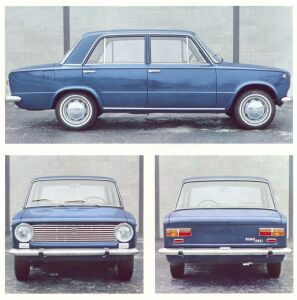 March
1966 witnessed the introduction of the new 124. Destined to replace the
1300/1500
it was an all new car of conventional front engine rear wheel drive layout,
powered by an 1197cc four cylinder engine with 60bhp (Images,
left side and
right side). Later that year,
at the Turin Motorshow, the 124 Station Wagon was also released (accompanied
by the Sport Spider, see below). The usual group of motoring journalists
also selected the 124 as the Car of the Year in 1966.
March
1966 witnessed the introduction of the new 124. Destined to replace the
1300/1500
it was an all new car of conventional front engine rear wheel drive layout,
powered by an 1197cc four cylinder engine with 60bhp (Images,
left side and
right side). Later that year,
at the Turin Motorshow, the 124 Station Wagon was also released (accompanied
by the Sport Spider, see below). The usual group of motoring journalists
also selected the 124 as the Car of the Year in 1966.
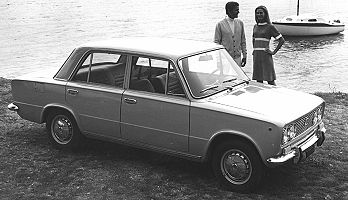 The final versions appeared in 1972, the
Berlina, Familiare (estate), Special and Special T all being revised. The
60bhp and 70bhp engines accrued another 5bhp each whilst the Special T
got a new 1592cc dohc engine with 95bhp and an optional five speed gearbox.
The final versions appeared in 1972, the
Berlina, Familiare (estate), Special and Special T all being revised. The
60bhp and 70bhp engines accrued another 5bhp each whilst the Special T
got a new 1592cc dohc engine with 95bhp and an optional five speed gearbox.
Spider
The second series, or BS, was introduced
in 1969. The standard BS car had the same 1438cc engine and a variety of
improvements, such as the addition of reversing lights and revised brakes.
Shortly afterwards (in 1970) the BS1 series introduced the 1608cc engine
from the 125 into the Spider, fitted with twin Weber
40 carburettors this produced 110bhp. This model was immediately distinguishable
by the addition of two humps in the bonnet required to clear the larger engine.
1972 saw the release of the CS series.
These used either the 1592cc (CS) or 1756cc engine (CS1) from the 132,
1972 also saw the release of the most potent Spider built, the Abarth Rally
(124CSA). This continued to use the 1756cc engine, but with twin 44IDF
carburettors it produced 128bhp. The rest of the car also experienced many
changes, the most significant of these including the fitting of a limited
slip differential, a new, independent rear suspension, composite bonnet
and boot and aluminium alloy doors. Just over 1,000 were built.
The next major change came in 1978 when
1982 saw a major upheaval for the Spider.
Complete production, including final assembly, was transferred to Pininfarina,
the car was renamed the Pininfarina Spider Azzura in North America and
sales were resumed in Europe where it was known as the Pininfarina Spidereuropa.
This series, the DS cars, were fitted with the 1995cc engine with Bosch
fuel injection which produced 102bhp in North America and 105bhp in Europe.
A final version arrived in 1983 in the
shape of the Spidereuropa VX. Unfortunately only 500 of these cars, fitted
with a supercharged 1995cc engine producing 135bhp were built.
Production of the Spider ceased in 1985
after approximately 198,000 had been built, just over 170,000 of those going to North America.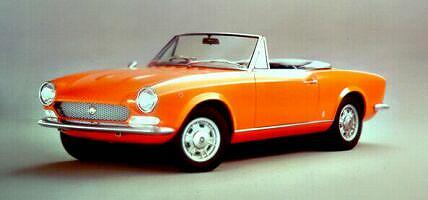 As
mentioned above, the Turin Motorshow of 1966 was the venue for the release
of the new 124 Sport Spider. Based on a shortened Berlina chassis, the
Spider body was designed and built by Pininfarina, final assembly being
carried out by Fiat. The first series, the AS cars, were fitted with a
1438cc dohc engine with 90bhp and a five speed transmission as standard.
From the end of 1968 the Spider adopted the new rear suspension as fitted to the 128 Special T.
As
mentioned above, the Turin Motorshow of 1966 was the venue for the release
of the new 124 Sport Spider. Based on a shortened Berlina chassis, the
Spider body was designed and built by Pininfarina, final assembly being
carried out by Fiat. The first series, the AS cars, were fitted with a
1438cc dohc engine with 90bhp and a five speed transmission as standard.
From the end of 1968 the Spider adopted the new rear suspension as fitted to the 128 Special T.
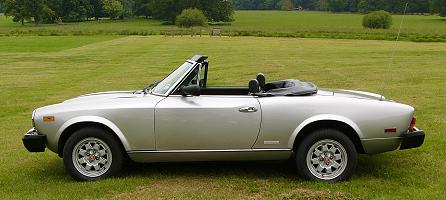 these generating 108bhp and 118bhp respectively, although both were fitted
only with single carburettors and are thus considered by many to be less
desireable than the earlier BS1, despite the slight power increase. These
were the last versions of the Spider to be sold in Europe, since after
1974 production was continued solely for the North American market. In
the latter the CS1 cars, known as Spider America, suffered from emissions
regulations which resulted in only 93bhp, and from 1976 only 87bhp.
these generating 108bhp and 118bhp respectively, although both were fitted
only with single carburettors and are thus considered by many to be less
desireable than the earlier BS1, despite the slight power increase. These
were the last versions of the Spider to be sold in Europe, since after
1974 production was continued solely for the North American market. In
the latter the CS1 cars, known as Spider America, suffered from emissions
regulations which resulted in only 93bhp, and from 1976 only 87bhp.
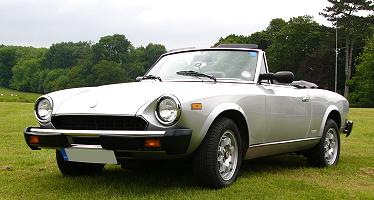 the CS2 was introduced using a 1995cc engine. Only available in North America
this produced a mere 87bhp, and even less in Californian spec cars. This
was then fitted with fuel injection in 1979 and became the CS0 with a slightly
improved 102bhp. In 1981 Fiat America joned forces with Legend Industries
and offered a Fiat Turbo 2000 Spider. These cars, some 1200 in total, had
a turbo kit fitted in America and were officially sanctioned by Fiat. In
this form the engine continued to use a modified Bosch fuel injection system
combined with an IHI turbo with 6psi of boost and produced 122bhp.
the CS2 was introduced using a 1995cc engine. Only available in North America
this produced a mere 87bhp, and even less in Californian spec cars. This
was then fitted with fuel injection in 1979 and became the CS0 with a slightly
improved 102bhp. In 1981 Fiat America joned forces with Legend Industries
and offered a Fiat Turbo 2000 Spider. These cars, some 1200 in total, had
a turbo kit fitted in America and were officially sanctioned by Fiat. In
this form the engine continued to use a modified Bosch fuel injection system
combined with an IHI turbo with 6psi of boost and produced 122bhp.
Coupé
The first changes came with the introduction
of the second series (BC) at the Turin Motorshow in 1969 when the front
of the car was heavily revised. The original two large headlights in the
wings were replaced by a full width grille and four small lights. The rear
of the car was also slightly modified. A new engine of 1608cc with 110bhp,
derived from the 125 unit, became available alongside
the existing 1438cc unit. The brakes and cooling system were also slightly
modified as was the suspension, the latter becoming softer and less sporty
and thus attracting some criticism.
The third series (CC) was introduced in
1972. The front end, especially the grille, was again revised as were various
other details such as the rear lights. The 1438 and 1608 engines were replaced
by two new dohc units of 1592cc and 1756cc with 104bhp and 114bhp respectively.
These were both derived from the units used in the 132.
Both of these variants could be fitted with a five speed transmission on request.
Production of the coupe continued until
1975 by which time approximately 299,686 units had been produced.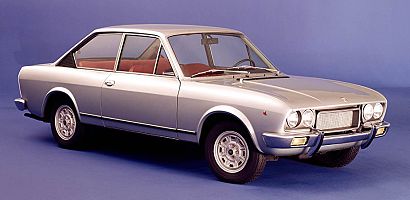 In
the year following the release of the Berlina and Spider, at the Geneva
motorshow of 1967, the new Sport Coupe based on the 124 was introduced
(AC series). The body was designed in-house by Fiat, using the mechanicals
of the Spider (1438cc 90bhp), but on the 2420mm wheelbase of the saloon.
Like the Spider, the new rear suspension was fitted to the coupe from the end of 1968.
In
the year following the release of the Berlina and Spider, at the Geneva
motorshow of 1967, the new Sport Coupe based on the 124 was introduced
(AC series). The body was designed in-house by Fiat, using the mechanicals
of the Spider (1438cc 90bhp), but on the 2420mm wheelbase of the saloon.
Like the Spider, the new rear suspension was fitted to the coupe from the end of 1968.
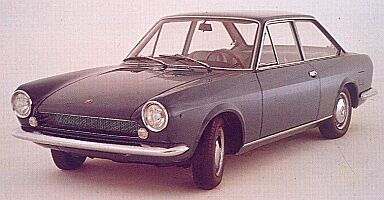 |
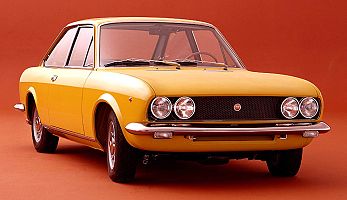 |
Other Variants
The 124 was also used by a variety of Italian coachbuilders as the basis of both one-off show cars and limited production runs. Moretti produced the 124 and 124S Coupes (with 1197cc and 1438cc engines) based on the saloon, whilst Vignale and Lombardi also produced Coupés based on the saloon. Touring Superleggera removed the roof from the standard saloon to produce a four-seat cabriolet, known as the 124C4. Some different saloon designs were also produced, see our Savio and Scioneri pages for some examples.
Technical Details
| Driveline | longitudinal engine at front with rear wheel drive
124 engines : Special 1438cc, Normal 1197cc left side and right side. |
| Suspension | front
: double wishbone with telescopic dampers and coil springs plus anti-roll bar
(Images :
1,
2,
3)
rear : live axle with telescopic dampers within coil springs later independent (Images : 1, 2) wheelbase : 2420mm (Berlina & Coupe); 2280mm (Spider) front track : 1330mm (berlina); 1350mm (Spider); 1346mm (Coupe) rear track : 1300mm (berlina); 1320mm (Spider); 1316mm (Coupe) |
| Brakes | front : discs, diameter 227mm
rear : drums, diameter 227mm handbrake operating on the rear via a cable |
| Gearbox | 4 and 5 speed manual
3 speed automatic |
| Steering | Worm and roller
2.75 turns lock-to-lock (Special) |
| Kerb Weight | Berlina (original 1197cc) : 855kg; Special : 925kg; Special T : 950kg
Sport Spider (srs I) : 945kg Sport Coupe (srs I) : 960kg; Srs II : 995kg |
| Dimensions | berlina/saloon, station wagon. |
Click here for a cutaway drawing of a 124 Berlina
Click here for a cutaway drawing of a 124 Sport Spider
Click here for a cutaway drawing of a 124 Spider Abarth Rally
Performance
| model | max speed | 0 - 100 km/h | standing km | braking from 100 km/h |
| 124 Sport Coupé 1400 (1967) | 170 km/h | 11.6 sec | 33.6 sec | 54.7 m |
| 124 Sport Spider 1400 (1967) | 170 km/h | 11.5 sec | 33.18 sec | 50.0 m |
| 124 Special (1968) | 155 km/h | 36.8 sec |
Tuning
The brakes can be improved by fitting drilled
and grooved discs, using a superior pad compound and fitting stainless
steel braided flexible hoses.
Dampers and springs are readily available
for the Spider which will improve the handling, and a strut brace can be
fitted at the front to increase the stiffness of the bodyshell.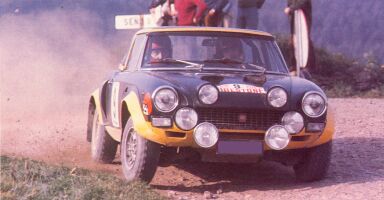 Easily
carried out modifications include installation of a free-flow air filter
(a cold air duct is also a worthy mod) and fitment of a less restrictive
exhaust system to improve the driveability. Depending on the model changing
the carburettors will make a significant difference, 40IDFs are a popular
choice, and can be coupled with an aftermarket camshaft for even better results.
Easily
carried out modifications include installation of a free-flow air filter
(a cold air duct is also a worthy mod) and fitment of a less restrictive
exhaust system to improve the driveability. Depending on the model changing
the carburettors will make a significant difference, 40IDFs are a popular
choice, and can be coupled with an aftermarket camshaft for even better results.
Maintenance
Remove, clean and grease the sliding blocks
between the brake callipers and brackets regularly ! If the flexible hoses
to the callipers are old then it is worthwhile changing them - they can
collapse internally which will lead to unpredictable braking.
Change the timing belt regularly according
to the manufacturers specification (and use OE (original equipment) items always!).
Buying / Selling
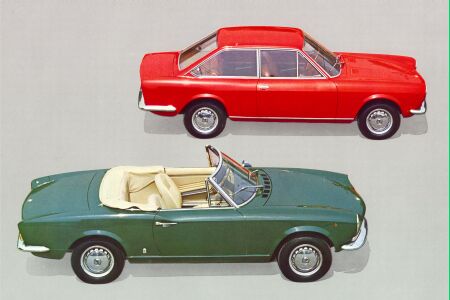
Some tips to do before selling :
(they may seem obvious, but most people don't do them and thus are in a weaker bargaining position)
Tidy inside the car thoroughly : hoover
the floor, empty all pockets, ashtrays (wash), glove compartment etc...,
wipe the trim with a damp cloth, give the cockpit a good airing to get
rid of any odours ! Reset the trip meter to 00000 - it is a pleasant (subconcious) surprise.
If the car has been standing give it a
good run (if possible!) - this will clear out the engine (reduce exhaust
smoke), put a shine on the brake discs and loosen up any joints that may otherwise make some noises.
'Back to black' products are very effective
at temporarily restoring bumpers and trim. This makes a big difference
to any car. Do it a week before you expect people to view the car, otherwise it may be a bit too obvious !
Jetwash under the car, especially under
the engine and in the wheelarches. The prospective buyer may be an enthusiast
(particularly likely with the 124 Spider and Coupe), and this makes it
easier for them to see what they want to check.
Obviously wash the car and clean the windows !
If you are going to buy a car always check the following :
Firstly check the bodywork. Pay special
attention to the wheelarches, suspension and engine mounts (check the inner
wings behind the springs and under the bonnet), sills, door pillars
(check for sagging doors), scuttle panel and the floor (doors, bonnet and
boot are also susceptible, but are more easily replaced). Check that the
front subframe is solidly fixed to the car and does not move away from
the body when the car is jacked up. Also check the front bulkhead near the clutch pedal.
Check for a damp carpet or the presence
of mould - if the carpet is damp then the floor is almost certainly corroded.
Check the main electrical functions - wipers,
lights, etc... try putting the main beam and wipers on at the same time.
Check the headlight reflectors for rust.
Check the brake pedal does not go to the
floor if pressed hard for a long time. Test the gearchange for clean engagement
and check that it does not jump out of any gear.
Find out when the timing belt was last
changed. If this is unknown then have it replaced.
Check tyre wear, uneven patterns could imply a bent chassis.
Always take it for a test drive. Check
that the car tracks in a straight line with no steering input and also
remains straight under braking. Find a large open area and complete several
lock to lock turns (also in reverse), listening for any noises. Try the
handbrake when moving - seized rear callipers will mean uneven braking or no braking. Check that there are no mismatching panels,
large areas of discolouration or signs of fresh paint (compare inside the
engine bay with the external body colour), all of which probably indicate accident damage.
Check that there are no mismatching panels,
large areas of discolouration or signs of fresh paint (compare inside the
engine bay with the external body colour), all of which probably indicate accident damage.
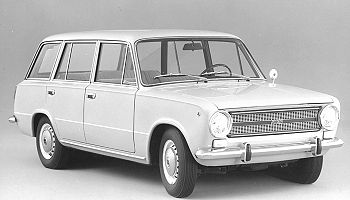 The engine should be run up to temperature, check the exhaust for smoke, the
condition of the breather (look for mayonaise), the condition of the oil
filler cap (again white deposits can indicate head gasket or other serious
problems) and the colour of the coolant (preferably not thick or dark brown!).
Listen to the noise of the engine, then depress the clutch and engage first
gear. Whatever noise has disappeared was coming form the gearbox, what
remains is from the engine. Pay special attention to the gearbox, since
it is a weakpoint of the 124. Also check the condition of the engine oil
on the dipstick. The lighter brown the better, if it is thick black then leave quickly.
The engine should be run up to temperature, check the exhaust for smoke, the
condition of the breather (look for mayonaise), the condition of the oil
filler cap (again white deposits can indicate head gasket or other serious
problems) and the colour of the coolant (preferably not thick or dark brown!).
Listen to the noise of the engine, then depress the clutch and engage first
gear. Whatever noise has disappeared was coming form the gearbox, what
remains is from the engine. Pay special attention to the gearbox, since
it is a weakpoint of the 124. Also check the condition of the engine oil
on the dipstick. The lighter brown the better, if it is thick black then leave quickly.
Links
The German Spider Owners Club website
The Italian 124 Spider register website
Fiat 124 Books :
buy them online here (in association with
Amazon)
 Fiat
Road Test Book :Fiat Pininfarina 124 and 2000 Spider 1968-85 Fiat
Road Test Book :Fiat Pininfarina 124 and 2000 Spider 1968-85
30 road tests covering almost all models made (European and North American) |
edited by R.M.Clarke, 1988 |
 Fiat
& Abarth 124 Spider & Coupe Fiat
& Abarth 124 Spider & Coupe |
John Tipler, 1998 |
| Fiat 124 Sport Automotive Repair Manual 1968-1978 | Haynes, 1979 |
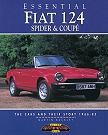 Essential Fiat 124 Spyder & Coupe :
The cars and their story 1966-85
Essential Fiat 124 Spyder & Coupe :
The cars and their story 1966-85
| Martin Buckley |
For more books on the Fiat 124 and other Fiats, see our Online Bookstore
124 comment form
Your Comments
Several things I've had happen
on my 78 Spyder, which the local garage says are not atypical:
I am on my fourth 124 coupe.
My first was in 1976 which was a CC. Now I have just bought a '73 CC coupe
which is in good condition. I have always thought the 124 coupe is one
of the most under rated models. (Maz, UK)
Of all the various 124's that I've owned. (8 to be precise) I noticed that white ones seemed to rust less than coloured ones.
Fantastic car. The Spider is still my all time favourite. The only thing that would better it would be a Dino! (Nick, Australia)
I have to agree with the notes below. I have owned over 150 FIAT cars, and nothing compares with the Coupe. I believe the reinforcement
over the rear shocks help to create a neutral handling capability that is not seen in other cars. The Coupe is becoming Rare and no less
impressive than it ever was, only comparable to the cars available today if not better. Pertaining to comments listed; 1) Clutch cable
problems are not unheard of. Most structural problems are a result of the cars not being undercoated by FIAT before shipping to the
U.S. Cars sold in the U.S. could experience serious rust or structural faults if not undercoated at the FIAT dealer at time of inception.
This is a critical factor in determining the purchase value of a car. You might in fact be buying parts. 2)Brake pull is often not a result of
the brakes. Inspect the fluid in the Idler unit, Steering box. The center link, Ball Joints, Tie Rods, and A-Arm buhings, and Ball joints
are always to be suspected. Otherwise put 4 new rotors, pads, etc. on and replace the brake pads every 20,000 miles, needed or not.
3)Elecrical corrosion is quite common. Fiat's never truly have electrical problems, just bad connections. Applying di-electric grease to
all of the female spades, along with a slight squeeze from a pair of pliers will rectify a lot of problems. 4)Ditto, drive them to their limits,
and they will treat you well.
I had a 124 1200, two 1600 Special T saloons. Lovely to drive, refined, rusty & very fast! (Nick, UK)
I love my 81 spyder 2000.such a beautiful car and the handling is great.i've had it for about 6 years and it still turns heads. (Morbius USA)
I have a 1974 special automatic 124 for 5 years now. it's fantastic, new paint, wheels and front lights, electrical antenna, c.d. and new interior.
it's fast,strong and beautiful. it's blue, and I'm crazy about her. Thanks to the Italians to create Fiat. wouldn't replace it!! best car I've had!!! (Avri, Israel)
1. Bulkhead when clutch
cable goes through. Metal flexes, eventually cracks, and pressure of clutch
pedal movement pulls it into the interior.
2. Pulling on braking -
seems ALL Spyders have a tendency to pull if brakes aren't perfect. Working
on mine - it pulls either direction, randomly...
3. Electrical corrosion
- saw note in one of the US newsletters (FLU, or one of the others) that
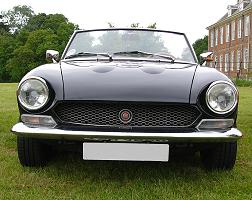 discussed replacing the grounding (earthing, for the Brits) crowns with better plated ones.
discussed replacing the grounding (earthing, for the Brits) crowns with better plated ones.
4. If buying one, keep in
mind that the 124's don't like sitting - a daily driver will give you less
problems than one that is only driven on sunny, dry days. (Gentle Ben, USA)
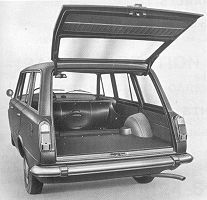 I'm located in Australia and was introduced to Fiat's through my Father who bought a Fiat 132s 1800 in 1973.I can remember when he picked it up and then took us for a drive in it and the distinctive exhaust sound had me sold for life.
Since then I have personally had many Fiats but my favorite is the Fiat 124 Sport 1800cc.
This was my first car upon getting my license in 1984 and is still with me today,although it's only used on weekends now when it's not raining.The car has been fully restored to original condition and still has the original blue cloth interior which looks great as the duco is white.
The car is complimented by 6J x 13 Cromodora Alloy Mags and has been fitted with an electronic Ignition System.
Whenever I take the car for a drive people always comment on what a beautiful looking car it is and I must say that the design of the 124 is elegant,sporty and classy which goes to show how ahead of their time the Italian Car designers where in the early sixties and seventies.
The Fiat 124 still gives me a thrill every time I drive it and always puts a smile on your face when you drive through those fantastic winding roads in the country side.
Its good to get on the web and read other peoples stories on their love affairs with Fiat's to realise that your not the only INSANE FIAT LOVER !!!!!!! (Anthony C, Australia)
I'm located in Australia and was introduced to Fiat's through my Father who bought a Fiat 132s 1800 in 1973.I can remember when he picked it up and then took us for a drive in it and the distinctive exhaust sound had me sold for life.
Since then I have personally had many Fiats but my favorite is the Fiat 124 Sport 1800cc.
This was my first car upon getting my license in 1984 and is still with me today,although it's only used on weekends now when it's not raining.The car has been fully restored to original condition and still has the original blue cloth interior which looks great as the duco is white.
The car is complimented by 6J x 13 Cromodora Alloy Mags and has been fitted with an electronic Ignition System.
Whenever I take the car for a drive people always comment on what a beautiful looking car it is and I must say that the design of the 124 is elegant,sporty and classy which goes to show how ahead of their time the Italian Car designers where in the early sixties and seventies.
The Fiat 124 still gives me a thrill every time I drive it and always puts a smile on your face when you drive through those fantastic winding roads in the country side.
Its good to get on the web and read other peoples stories on their love affairs with Fiat's to realise that your not the only INSANE FIAT LOVER !!!!!!! (Anthony C, Australia)
![]() There is also a list of all our picture galleries (including museums,
motorshows and various events).
There is also a list of all our picture galleries (including museums,
motorshows and various events).
Wallpapers/Desktop Backgrounds of numerous Fiats also available to download.
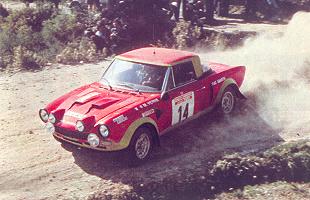
Use the buttons at the top to navigate
further, or
Copyright © 2000 to 2008 CarsfromItaly